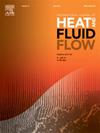Stefan blowing magnetized nanofluid flow past a convectively heated stretching curved surface with motile microorganism and chemical reaction
IF 2.6
3区 工程技术
Q2 ENGINEERING, MECHANICAL
International Journal of Heat and Fluid Flow
Pub Date : 2025-06-17
DOI:10.1016/j.ijheatfluidflow.2025.109945
引用次数: 0
Abstract
This study explores the magnetized nanofluid flow on a convective heated curved sheet with Stefan blowing slip effects. The flow is affected by heat sink/source effects as illustrated by energy equation. Magnetic field of intensity is employed in normal direction to flow of fluid. To control the mass and thermal diffusions, effects of thermophoresis and Brownian motion have used in both energy and concentration equations. The main equations have solved in dimensionless form through bvp4c approach. As outcomes of this work, it has discovered that, with surge in concentration difference factor, curvature factor, Schmidt number there is expansion in velocity panels. Temperature panels have enlarged with surge in Brownian motion, magnetic effects, Eckert number, thermal Biot number and heat source effects. The concentration panels have escalated with growth in thermophoresis factor, and curvature factor while declined with surge in Brownian motion parameter and chemically reactive factor. Microorganisms’ concentration distribution declined with surge in Peclet number and bioconvetion Lewis number while escalated with growth in curvature factor. Current results have been validated through comparative analysis, where a closed correlation between current results and the results as established has ensured that authenticates the current results.
Stefan吹风磁化纳米流体流过对流加热的拉伸曲面,使微生物运动并发生化学反应
本文研究了磁化纳米流体在对流加热弯曲片上的流动。由能量方程可知,流动受到热源/散热器效应的影响。在法向方向上施加强度为B0的磁场使流体流动。为了控制质量和热扩散,在能量和浓度方程中都使用了热泳动效应和布朗运动效应。通过bvp4c方法求解了主要方程的无因次形式。研究结果表明,随着浓度差系数、曲率系数、施密特数的增大,速度面板会出现膨胀现象。温度面板随着布朗运动、磁效应、埃克特数、热Biot数和热源效应的激增而增大。浓度板随热泳系数和曲率系数的增大而升高,随布朗运动参数和化学反应系数的增大而下降。微生物浓度分布随Peclet数和生物惯例Lewis数的增大而减小,随曲率因子的增大而增大。通过比较分析验证了当前结果,其中当前结果与已建立的结果之间的密切相关性确保了对当前结果的验证。
本文章由计算机程序翻译,如有差异,请以英文原文为准。
求助全文
约1分钟内获得全文
求助全文
来源期刊

International Journal of Heat and Fluid Flow
工程技术-工程:机械
CiteScore
5.00
自引率
7.70%
发文量
131
审稿时长
33 days
期刊介绍:
The International Journal of Heat and Fluid Flow welcomes high-quality original contributions on experimental, computational, and physical aspects of convective heat transfer and fluid dynamics relevant to engineering or the environment, including multiphase and microscale flows.
Papers reporting the application of these disciplines to design and development, with emphasis on new technological fields, are also welcomed. Some of these new fields include microscale electronic and mechanical systems; medical and biological systems; and thermal and flow control in both the internal and external environment.
 求助内容:
求助内容: 应助结果提醒方式:
应助结果提醒方式:


